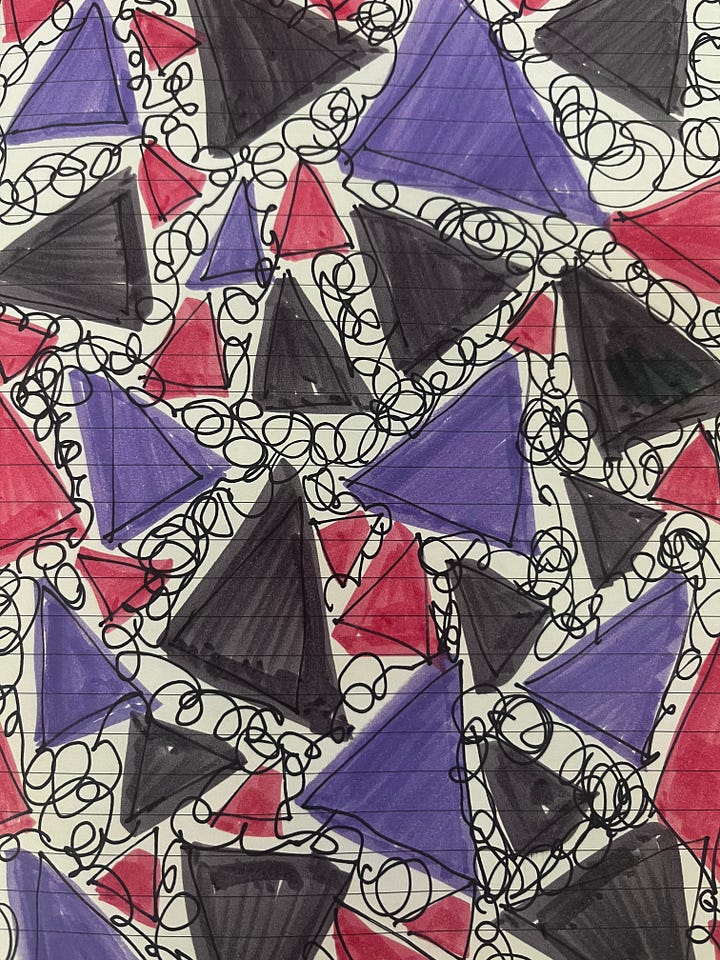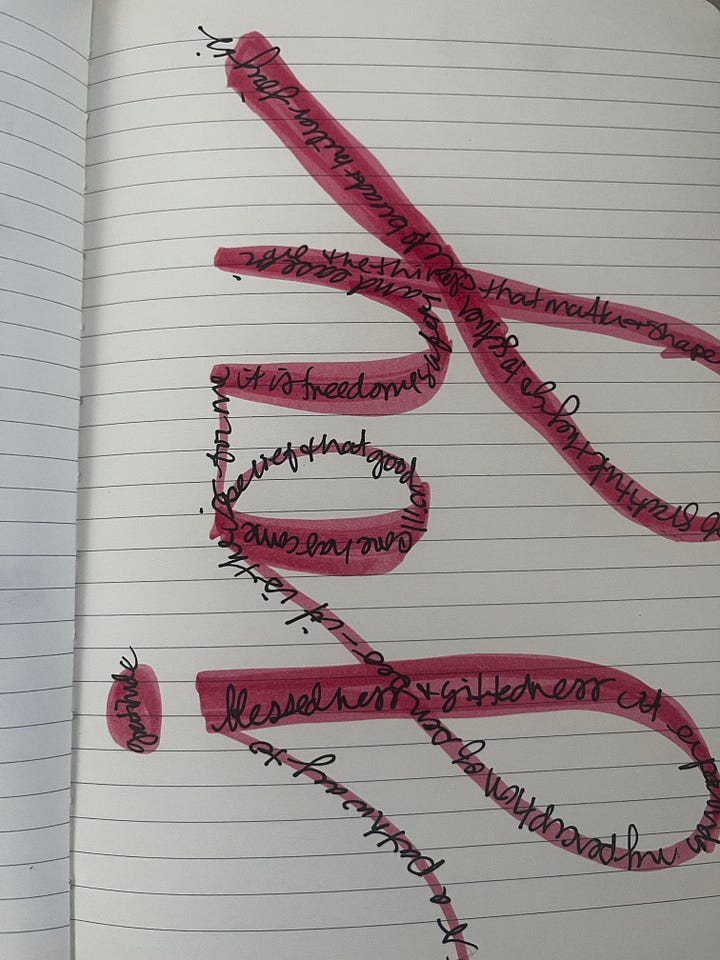Advent is the four weeks leading up to Christmas.
In the Episcopal tradition (and other liturgical traditions), Advent marks the beginning of a new liturgical year. (Happy New Year!)
Each Sunday of Advent, one candle is lit on the Advent wreath. Each candle represents a different theme: Hope, Peace, Joy, and Love.
A whimsical, engaging, FUN question popped into my mind a few weeks ago while I was sitting outside early in the morning, taking in a full moon.
The perfect circle of the moon whispered-what if shapes-just ordinary shapes offer us spiritual direction, guidance, and deeper meaning? What might we learn if we notice, listen, and pause with shapes?
For The Shape of Advent, I took a list of Advent themes. I paired a familiar shape (circle, square, triangle, knot) with each theme to see what they might offer us and how we could embody the shapes and themes.
WEEK 3: Joy & Triangle
How does joy, represented by a triangle, invite us into deeper meaning, purpose, and grace this Advent season?
{Joy}
This week, I was surprised to discover a summary of academic research on “the field of joy.”
Questions addressed in the research literature included:
What is joy?
How is joy defined? (There are several similar and conflicting understandings.)
How does joy work?
What studies have been conducted, and what still need to be done?
I had no idea there was so much academic, theological, and psychological interest in joy.
What makes joy so compelling?
Joy is a complex emotional state, making it interesting for researchers and theologians. All agree that joy can be felt along with sorrow, grief, confusion, and trials. Joy is an emotional state found in the hoped-for but not yet parts of life.
Joy is a process emotion, not an end-result feeling. Joy is about perception. “joy … is tied to how I perceive things rather than to what things are in themselves’ (Volf, Citation 2015).”
The research is fascinating and illuminating, but what does it mean practically? That’s where it matters and where my interest lies. How do we find, live, and spread joy?
The more I read about joy, the more I want to ensure it is part of my emotional toolbox. Joy can change perception and have physical impacts: colors are perceived as brighter, smiles are harder to suppress, and physical movements become more fluid and graceful!
One understanding of joy that resonates with me is that it contains a mixture of “blessedness” and “gratitude.”
Joy is not happiness and excitement at an outcome. Joy can be experienced and felt when the result isn’t yet achieved. Joy includes a sense that, as Saint Julian of Norwich reminds us, “all will be well.”1 Joy is found in the process.
Joy is a complex emotion and feeling. Joy happens when we find purpose and orientation toward hope and goodness in the messy, unknown, sometimes disappointing middle.
The blessedness part of joy is the understanding that even in trials, confusion, and the “not yetness” of life, there is a sense of purpose and blessing. “All will be well” somehow, someway at some point. “Joy attunes us to being open to new possibilities for relating to our circumstances and perceiving them in a new light” (Johnson 2019)
Joy says, “It’s not pretty, or clear now, but all will be well, somehow-and I’m grateful for what I have…now.”2
One of my favorite learnings about joy is the gratitude and joy feedback loop. The more we experience gratitude, the more we open ourselves up to joy, the more joy we feel, and the more gratitude we feel.3 It turns out that joy and gratitude empower each other. That sounds like a feedback loop I would like to live in.
{Triangle}
I used the triangle this week to help me understand the relationship between blessedness, gratitude, and joy.
My first impulse was to place joy at the triangle's peak, but the more I thought about it, the more I realized that blessedness felt like a downward motion and gratitude felt upward, making joy the base of the triangle, not the peak.
Blessedness is a sense of blessing, alignment, and goodness from a higher power. Blessings come to us outside of what we can create or control. Blessings are a gift.
Gratitude feels like an upward motion. We offer our thanks-gratitude in an upward motion for the downward flow of blessings and gifts we receive and perceive.
It felt right when I drew a triangle and wrote blessedness on one side, gratitude on the other, and joy as the foundation.
Joy is the foundation on which everything balances and finds alignment.

{The Invitation}
How do you define or understand joy? It’s interesting to define terms and ideas that we use constantly.
Another understanding of joy in the research is freedom, safety, and ease. Do those words resonate more for you? How would you arrange those words on a triangle?
{Traditional Practices}
Gratitude- Grateful Living is a wonderful place to start with articles, videos, and guidance for gratitude. Check out this (three) step gratitude practice StopLookGo. Here.
Examen: The Ignatian Examen is a daily practice of reflection on your day, most commonly done in the evenings. There are lots of good examples and variations here.
Triangle breath: Breathe in for three seconds, hold for three seconds, and breathe out for three seconds. Repeat the pattern for a minute or two. Learn more about the triangle breath practice here.
{Whimsical Practices}


Joy Defined: I wrote joy in bold letters in a highlighter and then used a black pen to write my definition of joy. I loved this simple practice. It helped me process all my reading and find what was most important to me.
Triangle Page: I filled a page with triangles. As I started, I wasn’t sure how it would work, but with each color, I found more triangle-shaped spaces where I could add “just one more triangle.” This exercise might not have a deep meaning, but playing with space and color was fun.
Google “Triangle Doodle Ideas”. There are so many creative ideas for doodling and playing with triangles. See if you find one that resonates with you!

A Joy + triangle blessing
May you find yourself caught in the triangle of blessings, gratitude, and joy as you live in the messy, not-yetness of life.
Julian of Norwich "… all shall be well, all shall be well, all manner of things shall be well"
joy is experienced when the outcome is hoped for, but not presumed (Miceli & Castelfranchi, Citation 2010)
“This suggests that being a more grateful person (dispositionally) may potentiate experiences of joy, and being a more joyful person (dispositionally) may potentiate experiences of gratitude, such that there may be a ‘virtuous upward spiral’ in which joy and gratitude mutually reinforce each other.” (Johnson 2019)




Helpful reflection. It fits well with Gaudete Sunday, Rejoice Sunday, since we know that the birth of the Prince of Peace is near.